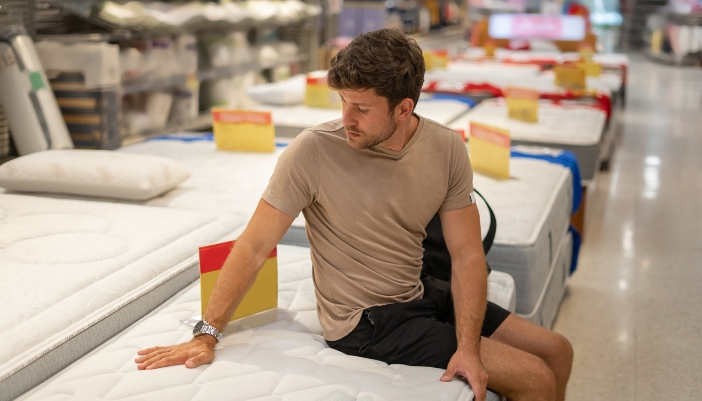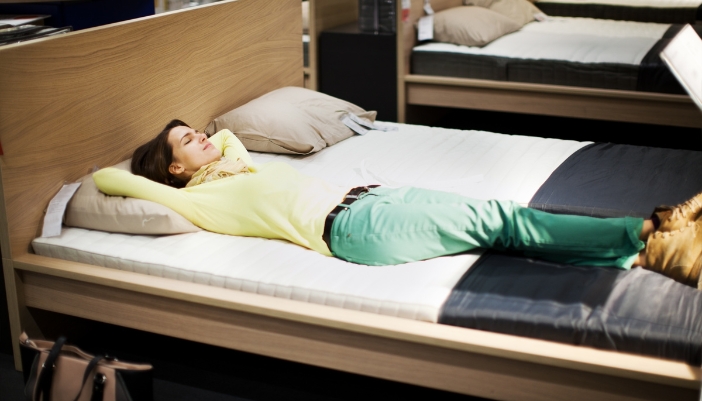A good night’s sleep can make or break your day, but the secret to more good days (and even better nights!) is having a mattress that fits your sleep. And to do that, you need to put each contender to the test — the mattress test!
When you test a mattress in-store, you feel it, lie down on it, and compare notes. But not all tests are equal! At Appliance Center, we’ll walk you through the best ways to test a mattress so you can find your ultimate fit for your sleep!
Preparing for Your Mattress Test

Getting ready to test mattresses in-store is more than just showing up. You want to be comfortable and prepared to maximize your mattress testing experience.
- Dress Comfortably: Wear clothes that let you move easily and lie down comfortably. Think of soft fabrics and relaxed fits that let you shift around and feel comfortable.
- BYOP (Bring Your Own Pillow): Taking one of your own pillows with you makes a huge difference. It’s the home comfort you’re used to, and it helps you get a more accurate feel for how the mattress will work with your sleep setup.
- Consider the Time of Day: Testing a mattress when you're naturally tired can give you a better sense of comfort and support. Aim to go mattress shopping in the late afternoon or early evening when your body is more in tune with sleep.
How to Test a Mattress In-Store

Now that you're ready, it's time to get down to business: testing those mattresses! Here’s how to make sure you get the most out of your in-store mattress test:
- 15-Min Test: Spend at least 15 minutes on each mattress to really get a feel for it. Your body needs a few minutes to adjust, and give you honest feedback about comfort and support.
- Test Different Sleep Positions: Make sure to test each mattress in all your typical sleep positions. Whether you sleep on your back, side, or stomach, spend a few minutes in each position to see how the mattress supports you.
- First Impressions Matter: When you lie down, notice how the mattress feels. The comfort layer should provide a cushioned feel that contours to your body without feeling too firm or too soft!
- Assess Motion Transfer: If you share your bed, have your partner roll around while you lie still to see how much movement you feel. Minimal motion transfer is key for a restful night, as it prevents you from being disturbed by your partner's movements.
What to Look for During the Test

When testing mattresses, it’s crucial to know what specific features to pay attention to! We know it’s hard to pay attention when you’re comfy but trust us, you’ll be happy you did!
- Firmness: Heavier individuals often need firmer mattresses to prevent sinking, while lighter individuals might prefer softer ones for adequate cushioning. Side sleepers typically need a medium to soft mattress to cushion the shoulders and hips, while back and stomach sleepers usually benefit from medium to firm options to support spinal alignment.
- Support: Ensure the mattress keeps your spine in a neutral position without needing to shift your position. Lie down and check if your spine maintains its natural curve when on your back and stays straight when on your side. Proper support helps avoid back pain and ensures restful sleep.
- Pressure Relief: Identify points of discomfort or pressure. Lie on the mattress and notice if any part of your body, like your hips, shoulders, or lower back, feels excessive pressure. A good mattress should evenly distribute your weight to relieve pressure points and avoid pain.
- Temperature Regulation: Some mattresses, especially those with memory foam, can retain heat. So, if you’re a hot sleeper, look for mattresses with cooling technologies, such as gel-infused foam or breathable covers.
- Durability: Assess the quality of materials and construction. Check for strong edge support by sitting on the edge of the mattress to see if it holds up. Look at the stitching and overall build to ensure it can withstand regular use without sagging or losing support over time.
Pro Tip:
If you need to cross your legs or feet while testing a mattress, it might mean it’s not supporting you well — you could be subconsciously trying to alleviate the discomfort caused by insufficient spinal alignment or weight distribution!
Additional Tips for a Successful Mattress Test

As you can see, a lot goes into testing a mattress to know if it’s the perfect fit for your sleep — including these additional tips!
- Bring Your Sleep Partner (If Applicable): If you share your bed, it's essential to bring your sleep partner. Your preferences might differ, and testing together ensures you both find a mattress that meets your needs.
- Ask Questions: Don't hesitate to ask our team about the mattress components. Understanding what the mattress is made of, such as the types of foam, coils, or other materials, helps you gauge its durability and comfort.
- Take Notes: As you test different mattresses, note your impressions of each. Write down how each mattress feels, including the level of comfort, support, and any pressure points you notice, so you can better compare your options later!
- Listen to Your Body: Trust your instincts regarding comfort and support. If you feel discomfort, pressure, or the need to shift positions frequently, the mattress might not be right for you. Pay attention to how your body feels and prioritize mattresses that offer the most natural and comfortable support.
So, are you ready to put your knowledge to the test? Visit Appliance Center for the mattress upgrade to keep you comfortable and snoozing all night!


